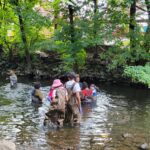Happy #BlackBotanistsWeek! Black Botanists Week is from July 5th through July 11th where people are encouraged to speak about the importance of diversity in botany through stories, poems, photographs, and more.
At this current moment in time, it seems like all we hear about is Black trauma. We hear about the victims of police brutality, the truths about historical figures we label as heroes, and stories that point to a larger systematic issue of how Black people are treated in America. These problems are absolutely essential to bring up at the forefront of our social and political discussions.
However, it is equally important to understand that Black people are more than just the hardships they face. At their core, they are individuals who have a love for life and the passions it cultivates. Among these interests is botany, the study of plants. In light of Black Botanists Week, we have decided to honor Marie Clark Taylor.
Marie Clark Taylor was born on January 1st, 1911 (making her a Capricorn!). She was born in the Allegheny County of Sharpsburg, Pennsylvania. In 1929, she graduated from Dunbar High School in Washington D.C with honors. After this, she attended Howard University and graduated in 1933 with a Bachelor of Science and later on in 1935 with a Master of Science in botany. After teaching for six years, she finally ended up at Fordham University in the Bronx and received her doctorate in 1941. There, she had written about how photoperiods (the amount of time an organism receives light) affects the growth of floral primordia (a name in plant biology which describes what gives rise to a flower).
In and of itself, Taylor’s accomplishments in her education are outstanding. But what makes them even more powerful is that she did this all 23 years before the Civil Rights Act of 1964 (which prohibited discrimination across all facilities) was passed and more notably, 13 years before Brown v. Board of Ed (which desegregated the country) in 1954. Beyond that, she was the first woman of any race to receive a scientific doctorate from Fordham. She would even protest racial inequality quietly in the halls of Rose Hill.
She began teaching at Cardozo High school, a historically Black high school in Washington D.C., but this teaching time got cut short by World War II where she had to join the Army Red Cross and serve in the Pacific. But perhaps this wasn’t so unlucky because it’s where she met her husband, Richard Taylor in New Guinea.
When she returned, she married Taylor (and officially became a Taylor!). She became an assistant professor at Howard University, during this time she gave birth to her son. Conveniently, it was after finals, starting the joke that she planned out her pregnancy. But her dedication to revolutionizing the way science was taught was no joke. She used grants from the National Science Foundation to purchase real botanical materials that, when observed under a light microscope, gave students a more detailed understanding of the life cycle of a plant. Taylor’s work was recognized by President Lyndon B. Johnson in the 60s and which led to her teaching methods being implemented on a national scale.
Taylor oversaw the construction of the botanical greenhouse laboratory at Ernest E. Just Hall Biology Building, a hall which was eventually renamed after her. She had retired in 1976 and died on December 1st, 1990 at 79 years old. Her pedagogical methods are still used to this day as a standard for education in botany.
Taylor grew up during the time of Jim Crow. Despite the major systems of oppression she faced, she had a major impact. She was a botanist who was a part of improving our education system. She was a wife and a mother. She was a veteran. She was a professor. And she is merely one example of how Black people are more than just stories of tragedy, and rather multifaceted individuals with their own personal lives and upbringings.





